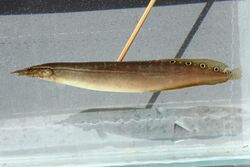Biology:Macrognathus siamensis
| Macrognathus siamensis | |
|---|---|

| |
| Peacock eel from Nakhon Phanom, Thailand | |

| |
| Peacock spiny eel from Miami-Dade County, Florida | |
| Scientific classification | |
| Domain: | Eukaryota |
| Kingdom: | Animalia |
| Phylum: | Chordata |
| Class: | Actinopterygii |
| Order: | Synbranchiformes |
| Family: | Mastacembelidae |
| Genus: | Macrognathus |
| Species: | M. siamensis
|
| Binomial name | |
| Macrognathus siamensis (Günther, 1861)
| |
| Synonyms[2] | |
| |
The peacock eel or spotfin spiny eel (Macrognathus siamensis) is a spiny eel found in freshwater habitats throughout Southeast Asia. They are commercially important as food and aquarium fish.[3]
Distribution
The peacock eel is native to the Mekong and Chao Phraya basins, which make up the countries of Thailand, Cambodia, Laos, and Vietnam.[4] They are mostly found in slow-moving backwaters that have a sandy or muddy bottom, such as swamps, canals, and ponds.[5]
There is an invasive population of peacock eels in the Everglades region of Florida, most likely being released due to the aquarium trade.[4][6][7] The eels were first discovered in the C-111 canal in 2002, and in 2004 were also found to inhabit mangrove swamps further south.[8]
Description
These fish lack scales and require a soft substrate to burrow into, such as sand, mud, or silt. They breed during the wet season when adjacent forests flood. Larvae reach 8 cm (2 in) in length in approximately 60 days after hatching.[9]
This eel can grow up to 30 cm (12 in) in length, although 20 cm (8 in) is more common.[4] Males and females are hard to tell apart through external means.[10]
Ecology
Their main diet is small crustaceans, annelids, and fish.[4]
References
- ↑ Vidthayanon, C. (2012). "Macrognathus siamensis". IUCN Red List of Threatened Species 2012: e.T180869A1672138. doi:10.2305/IUCN.UK.2012-1.RLTS.T180869A1672138.en. https://www.iucnredlist.org/species/180869/1672138. Retrieved 20 November 2021.
- ↑ Froese, Rainer and Pauly, Daniel, eds. (2019). "Macrognathus siamensis" in FishBase. August 2019 version.
- ↑ "The truth about spiny eels | Practical Fishkeeping magazine". http://www.practicalfishkeeping.co.uk/pfk/pages/show_article.php?article_id=630. Retrieved 2008-11-24. [|permanent dead link|dead link}}]
- ↑ 4.0 4.1 4.2 4.3 "Peacock Eel (Macrognathus siamensis) Ecological Risk Screening Summary". 3 August 2018. https://www.fws.gov/fisheries/ans/erss/uncertainrisk/ERSS-Macrognathus-siamensis-final-August2018.pdf.
- ↑ Binohlan. "Macrognathus siamensis (Günther, 1861)". https://www.fishbase.de/summary/Macrognathus-siamensis.html.
- ↑ "Spotfin Spiny Eel". https://www.floridamuseum.ufl.edu/discover-fish/florida-fishes-gallery/spotfin-spiny-eel/.
- ↑ Fuller (23 August 2019). "Macrognathus siamensis (Günther, 1861)". https://nas.er.usgs.gov/queries/factsheet.aspx?SpeciesID=2261.
- ↑ Kline (June 2013). "Recent Fish Introductions Into Everglades National Park: An Unforeseen Consequence of Water Management?". Wetlands 34: S1. https://www.researchgate.net/publication/257797168.
- ↑ Saowakoon (2007). "Breeding and nursing of spotted spiny eel (Macrognathus siamensis; Gunther, 1861).". Proceedings of the 45th Kasetsart University Annual Conference, Kasetart. https://www.cabdirect.org/cabdirect/abstract/20073204181.
- ↑ Saowakoon (2007). "Some aspects on reproductive biology of spotted spiny eel (Macrognathus siamensis, Gunther, 1861) case study in Surin and Buriram provinces, Thailand [2007"]. Proceedings of the 45th Kasetsart University Annual Conference: 722–731. https://agris.fao.org/agris-search/search.do?recordID=TH2008000251.
External links
Wikidata ☰ Q1761494 entry
 |


